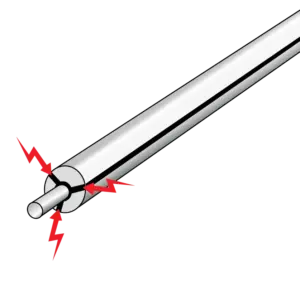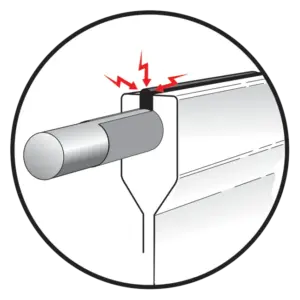How many volts should an electric fence for horses have? Most experts recommend 2,000–3,000 volts as the minimum, with 3,000 volts being the ideal range. In certain conditions, like long fence runs or heavy vegetation, starting at 4,000–5,000 volts ensures the fence still delivers enough shock at the far end.
This guide explains the right electric fence for horses voltage, how to maintain it, and what factors affect performance. You’ll also learn about joules, installation, safety tips, and training strategies to keep your horses safe and contained.
Why Voltage Matters in Horse Electric Fencing
Electric fencing isn’t about pain — it’s about respect through memorability. Horses are animals with flight instincts, and once they learn the boundary, they avoid testing it again. Voltage is the key factor that makes this possible.
- Low voltage (<2,000 V): Horses may lean on or push through the fence. Over time, they’ll learn it’s ineffective.
- Optimal voltage (≈3,000 V): Provides a quick, sharp shock that startles without harm. This teaches respect after just a few encounters.
- Excessive voltage (>8,000 V): Not more effective and risks causing unnecessary stress.
The Reality: Is More Voltage Always Better?
Many assume “the more volts, the better.” In truth, consistency matters more than extremes. A fence that consistently measures 3,000 volts across all lines is far more effective than one that spikes to 8,000 near the energizer but drops to 1,500 at the far corner.
How Voltage Influences Containment and Safety
Horses are intelligent but can be stubborn. If they test a weak fence once, they’ll often test again. The right voltage delivers a quick correction, keeping horses off of the fence and discouraging bad habits like cribbing or leaning.
Recommended Voltage Ranges for Horse Fencing
The right range depends on your setup and environment. Here’s what experts recommend:
Minimum Safe Voltage Levels
A horse fence must deliver at least 2,000 volts to register through a horse’s coat, especially in winter when hair is longer.
Ideal Voltage for Reliability and Training
3,000 volts is the sweet spot for most buyers. It’s strong enough to be memorable but mild compared to the higher requirements for cattle or predators.
When Higher Voltage Makes Sense
- Vegetation load: In summer, weeds touching the wire will bleed off voltage. Starting with 4,000–5,000 volts ensures your fence still delivers 3,000 volts where it matters.
- Long runs: The longer the fence, the more resistance builds up. Higher voltage helps maintain effectiveness.
- Multiple animals: Larger herds test fences more often; extra voltage ensures consistency.
Pro Tip: Oversizing your energizer slightly ensures a buffer for seasonal changes. Buying “just enough” often leads to poor performance by midsummer.
Key Factors That Affect Voltage Performance
Even if your energizer produces 5,000 volts, your fence may not deliver it to the horse. These are the most common limiting factors:
Vegetation Load and Seasonal Changes
Tall grass, weeds, and shrubs sap electricity. Each blade touching the wire drains small amounts of power, collectively lowering fence voltage.
Solution: Mow fence lines, or accept that summer will reduce your fence’s effectiveness and plan by starting at higher voltage.
Fence Length and Conductor Resistance
The longer your fence, the more resistance electricity faces. Resistance increases with distance, lowering voltage.
- Short runs: Resistance is not as much of an issue
- Long runs: High-tensile 12.5-gauge wire carries voltage more efficiently across distance.
Conductor Materials: Wire vs. Rope & Tape
- Electrifiable Coated Wire: High-tensile wire with added visibility and smoothness while being able to conduct electricity through graphite strips.

- Electrifiable Rail: Combines the low resistance of high-tensile wire with the aesthetics of flexible rail. Graphite strips carry charge from the high-tensile wire to the surface.

- Electric Rope & Tape: Come with relatively higher resistance compared to steel wire.
Pro Insight: Using combinations and rail and wire can create more options for doing long runs of electric fencing at lower costs.
Volts vs Joules: Understanding the Difference
When shopping for energizers, you’ll see both volts and joules listed.
- Volts: Electrical pressure. Determines whether the horse feels the shock.
- Joules: The energy per pulse. Determines how far and through what resistance the charge can travel.
Why Both Matter
Think of volts as speed and joules as fuel. A car going fast without fuel won’t go far; a fuel-heavy car going slow won’t feel powerful. Together, volts + joules make the fence effective.
Low-Impedance Energizers
For horse fencing, always choose a low-impedance energizer. These deliver consistent voltage through weeds and long fences.
Buyer Tip: For horses, an energizer with around 1 joule output per mile of fence paired with 3,000+ volts works well. Larger properties or multi-paddock systems may require 2+ joules.
Designing and Installing a Reliable Horse Fence
Voltage is only as strong as your design and installation.
Grounding Essentials and Rod Spacing
Up to 80% of electric fence issues trace back to poor grounding.
- Use at least 3 galvanized rods (6–8 ft long). Space each rod about 1.5 times its length apart (e.g., 6 ft rods – 9 ft spacing, 8 ft rods – 12 ft spacing).
- Connect with ground clamps and wire designed for the system.
- You must measure less than 1,000 volts on your ground rod with a tester. If higher, add another rod at the correct spacing to bring it down and increase fence voltage.
- In dry climates, consider 4–5 rods for reliability.
Charger Placement and Insulated Lead-Out Cables
Install chargers in a sheltered, dry area. Run insulated cable rated up to 20 kV when burying or spanning long distances.
Regular Testing: Using Voltmeters and Fault Finders
A digital fence tester (or fault finder) lets you measure at multiple points. Test weekly and always check the farthest corner. If the charger outputs 5,000 V but the far end only has 1,500 V, you have a problem.
Best Practice: Keep a logbook of voltage readings across the seasons. Patterns reveal early signs of shorts, loose wires, or grounding issues before failure.
Planning for Future Expansion
When designing your fence, think ahead to possible dividers or added pastures. Extra length lowers voltage, so plan for a charger with enough joule rating to handle future growth.
Training Your Horse to Respect the Fence
Even the perfect voltage won’t help if your horse doesn’t see or understand the boundary.
- Visibility: Coated wire and rail are easier for horses to see, reducing accidental collisions. They also come with lower entanglement risk compared to bare wire.
- First introduction: Place horses in the paddock during daylight when they can see the fence. Some owners place hay a few feet away from the fence to encourage cautious exploration.
- Observation: Watch initial interactions. Most horses touch the fence once or twice and learn quickly.
Pro Insight: Horses learn by association. Visible fencing helps them connect the shock with the barrier, reducing injury risk.
Key Takeaways
- Horses need at least 2,000–3,000 volts, with 3,000 V ideal.
- Heavy vegetation or long lines require 4,000–5,000 volts at the charger.
- Joules matter as much as volts: think speed + fuel.
- Always use low-impedance energizers for reliability.
- Test your fence weekly, especially at the farthest point.
- Combine visibility and grounding for maximum safety and function.
- Oversize your energizer to stay ahead of seasonal drops.
FAQs
- What voltage should a horse electric fence be?
At least 2,000–3,000 volts, with 3,000 volts ideal for reliability. - Why is my fence voltage lower in summer?
Weeds and grass drain electricity. Starting with higher voltage ensures consistent performance. - Do I need a high-joule energizer?
1 joule output per mile of fence is a good rule of thumb. Larger systems may need 2+ joules. - How often should I test my fence voltage?
Weekly and always check at the farthest point from the energizer. - Is electric fencing safe for horses?
Yes. It delivers a quick, harmless correction to look out for your horses and fencing investment.